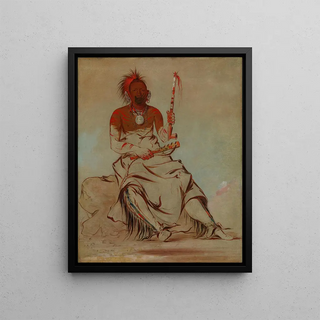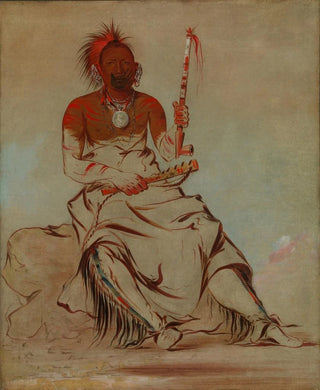Art print | Te-Ah-Ke-Ra-Le-Re-Coo The Cheyenne, a Pawnee republican - George Catlin


View from behind

Frame (optional)
In the fascinating universe of 19th-century American art, George Catlin's work emerges as a poignant testament to Native American cultures. The art print Te-Ah-Ke-Ra-Le-Re-Coo the Cheyenne, a Pawnee republican - George Catlin, not only illustrates the beauty of Catlin's portraits but also his commitment to authentic representation of indigenous peoples. Through this piece, the artist succeeds in capturing the essence of an individual while bearing witness to a period marked by social and cultural upheavals. The richness of details and the expression of the subjects invite the viewer on a journey through time, to meet an often little-known and misunderstood identity.
Style and uniqueness of the work
Catlin's style is distinguished by a blend of realism and romanticism. His portraits, such as that of Te-Ah-Ke-Ra-Le-Re-Coo, reveal a technical mastery that transcends mere visual rendering. The artist uses vivid colors and dynamic compositions to bring his subjects to life, endowing them with dignity and depth that resonate with the viewer. The Cheyenne's posture, his intense gaze, and traditional clothing are all elements that testify to the cultural richness of Native American peoples. Catlin does not merely reproduce figures; he tells stories, evokes traditions, and raises questions about identity and memory. Every brushstroke seems to carry the weight of history, inviting reflection on the place of indigenous peoples in the American narrative.
The artist and his influence
George Catlin, often regarded as the first painter of the American West, dedicated his life to documenting Native tribes before they disappear in the face of colonial expansion. His work is the result of passionate commitment and a desire to preserve a culture on the brink of extinction. Traveling across the United States, Catlin collected not only portraits but also stories, objects, and memories. His influence extends far beyond his time, inspiring generations of artists and

Matte finish

View from behind

Frame (optional)
In the fascinating universe of 19th-century American art, George Catlin's work emerges as a poignant testament to Native American cultures. The art print Te-Ah-Ke-Ra-Le-Re-Coo the Cheyenne, a Pawnee republican - George Catlin, not only illustrates the beauty of Catlin's portraits but also his commitment to authentic representation of indigenous peoples. Through this piece, the artist succeeds in capturing the essence of an individual while bearing witness to a period marked by social and cultural upheavals. The richness of details and the expression of the subjects invite the viewer on a journey through time, to meet an often little-known and misunderstood identity.
Style and uniqueness of the work
Catlin's style is distinguished by a blend of realism and romanticism. His portraits, such as that of Te-Ah-Ke-Ra-Le-Re-Coo, reveal a technical mastery that transcends mere visual rendering. The artist uses vivid colors and dynamic compositions to bring his subjects to life, endowing them with dignity and depth that resonate with the viewer. The Cheyenne's posture, his intense gaze, and traditional clothing are all elements that testify to the cultural richness of Native American peoples. Catlin does not merely reproduce figures; he tells stories, evokes traditions, and raises questions about identity and memory. Every brushstroke seems to carry the weight of history, inviting reflection on the place of indigenous peoples in the American narrative.
The artist and his influence
George Catlin, often regarded as the first painter of the American West, dedicated his life to documenting Native tribes before they disappear in the face of colonial expansion. His work is the result of passionate commitment and a desire to preserve a culture on the brink of extinction. Traveling across the United States, Catlin collected not only portraits but also stories, objects, and memories. His influence extends far beyond his time, inspiring generations of artists and






